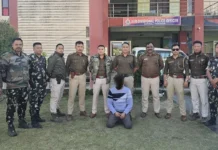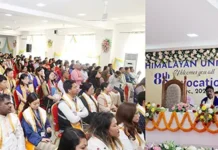[Tongam Rina]
ITANAGAR, Dec 26: This year’s first black-necked crane arrived in its wintering site in Pangcheng valley, along the Nyamjang Chhu river, in Tawang district, on 25 December.
Last year, the cranes had landed on 3 December.
Digen Dorjee, a teacher who spotted the revered crane, said it is likely that “the lone crane has come on a recce, before finalizing whether to make the valley its winter home.”
“In the last 10 years that I have watched them, a lone crane comes first, returns, and then brings the young ones, depending on whether the site is undisturbed,” he told this daily.
The crane was spotted at the proposed barrage site of the NHPC’s 780 mw Nyamjang Chhu project.
A short 3-km stretch of the Nyamjang Chhu river, between Brokenthang and Zemithang, is one of the only two regular, long-term wintering sites of the bird in India. In 2017, due to habitat destruction in the 3-km stretch because of sand and gravel mining and construction, the cranes did not land, though they had come as far as their wintering habitat.
The other wintering site is Sangti valley, in neighbouring West Kameng. Chug valley in the same district is also a known wintering site for black-necked cranes.
The National Green Tribunal (NGT) in a landmark judgment on 7 April, 2016, had suspended the environmental clearance granted to the Nyamjang Chhu project’s barrage site, submergence of which will destroy the wintering site of the bird. The appeal had been filed by the Save Mon Region Federation.
The environment impact assessment report on the project had failed to record the importance of the wintering site, and in fact did not mention the black-necked crane even once.
The NGT in its judgment further directed the Wildlife Institute of India to conduct an impact assessment of the project on the black-necked crane.
Last year, black-necked cranes arrived in Sangti valley also in the first week of December. The cranes had attempted to land a few days earlier, but because of paragliding in the area by the National Institute of Mountaineering & Allied Sports (NIMAS), Dirang, the birds returned.
The birds finally returned after the villagers requested the NIMAS to stop paragliding in the area from November to March, so that the movement of the cranes is not disturbed.
Between 2009 and 2013, not a single crane had come to Sangti valley. Experts say that it was because of habitat destruction and a change in the cultivation pattern in that area. High tension power lines also run through the entire stretch of the habitation of cranes.
In 2016, two cranes were killed when they were snagged on a high-voltage power line in Sangti valley – the second such incident since 2007. In 2008, a black-necked crane was killed by an Arunachalee government employee who was not from the area, locals say.
In 2017, the black-necked cranes did not arrive in Sangti valley, Zemithang and Chug valley.
The cranes are revered by the Monpas as the embodiment of the 6th Dalai Lama, Gyalwa Tsangyang Gyatso, who was born in Tawang in 1683. He has written about the majestic bird in poems, and has used it as an imagery of his return.




